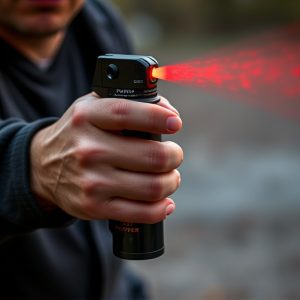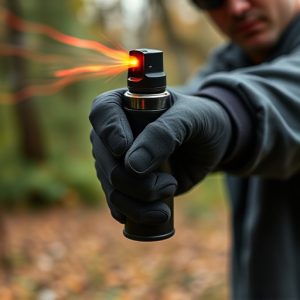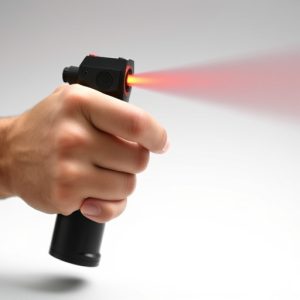Capsaicin-Based Personal Protection: Unlocking Self-Defense Power
Tactical pepper spray, leveraging capsaicin's pain-inducing properties, is a potent self-defens…….
Tactical pepper spray, leveraging capsaicin's pain-inducing properties, is a potent self-defense tool with diverse deployment methods tailored to various scenarios. Law enforcement and individuals alike employ these techniques for temporary blindness and disorientation of assailants, providing escape or backup time. Personal Protection Devices (PPDs) featuring capsaicin technology offer compact, robust designs with advanced features like adjustable spray patterns and UV lights. Effective yet non-lethal, proper training, maintenance, and understanding legalities ensure safe use, making tactical pepper spray a valuable asset for personal protection in urban areas and outdoor adventures.
“Discover the power of nature’s defense mechanism with capsicum-based personal protection devices. This article explores how capsaicin, the active ingredient in chili peppers, revolutionizes self-defense strategies. From understanding its effects to examining tactical pepper spray deployment methods and innovative PPD designs, we delve into the effectiveness and safety of this natural solution.
Learn about the strategic deployment techniques, explore key features, and understand the legal and ethical considerations surrounding capsicum-based self-defense tools, offering a comprehensive guide to modern personal protection.”
- Understanding Capsaicin: The Active Ingredient
- Tactical Pepper Spray: Deployment Techniques
- Personal Protection Devices (PPDs): Design and Features
- Effectiveness and Safety Considerations
- Legal and Ethical Implications of Capsaicin-Based Self-Defense
Understanding Capsaicin: The Active Ingredient
Capsaicin, the active ingredient in tactical pepper spray, is a natural compound derived from chili peppers. It’s what gives spicy foods their heat and has been utilized for centuries not only in cuisine but also in traditional medicine. In the context of personal protection, capsaicin creates a powerful defensive tool by triggering pain receptors in the eyes, nose, and skin. This sudden sensation distracts and disorientates potential attackers, providing an opportunity to escape or deploy other self-defense measures.
Understanding how capsaicin interacts with the body’s sensory systems is key to effective tactical pepper spray deployment methods. When sprayed, the compound binds to specific receptors, causing a chain reaction of events that leads to temporary but intense discomfort and reduced mobility in the target area. This knowledge empowers individuals to use such devices confidently, knowing they have a reliable and legal means of self-defense at their disposal.
Tactical Pepper Spray: Deployment Techniques
Tactical pepper spray, a powerful personal protection device, offers unique deployment techniques tailored for various scenarios. Law enforcement officers and security professionals often employ these methods during high-risk situations, utilizing the spray’s effectiveness to incapacitate or deter potential threats. One common technique involves aiming for the eyes, as the spray can cause temporary blindness and severe irritation, disorienting the assailant long enough to enable a safe escape or the arrival of backup.
The deployment range is another critical aspect; users must be aware of the distance at which they can effectively deploy the spray. Close-range applications are ideal for neutralizing an attacker swiftly, while longer-range techniques allow for a safer distance, giving the user more time to assess and react to the situation’s dynamics. Proper training in these deployment methods ensures maximum efficiency and safety during encounters, making tactical pepper spray a versatile asset in personal protection strategies.
Personal Protection Devices (PPDs): Design and Features
Personal Protection Devices (PPDs) designed with capsaicin, often incorporating tactical pepper spray deployment methods, are equipped with various features to enhance safety and effectiveness. These devices typically feature a compact and robust design, allowing for easy carry and quick access during emergencies. The spray mechanism is designed to disperse capsaicin, a compound derived from chili peppers, which irritates the eyes, nose, and throat, temporarily incapacitating an attacker.
Key tactical features include adjustable spray patterns, wind-resistant nozzles, and various deployment options such as hand-activated triggers or pressure-sensitive releases. Some models also incorporate UV lights for identifying hidden threats in low-light conditions or temperature sensors to detect potential attacks based on sudden changes in body heat. These advanced features make capsaicin-based PPDs versatile tools for personal safety in diverse environments, from urban streets to outdoor adventures.
Effectiveness and Safety Considerations
The effectiveness of a capsaicin-based personal protection device, often in the form of tactical pepper spray, lies in its ability to disable or deter potential threats through a unique chemical compound derived from chili peppers. This non-lethal self-defense tool has gained popularity due to its swift action, temporarily blinding and disorienting assailants, allowing users to escape or seek help. The active ingredient, capsaicin, triggers sensory nerve endings, causing intense pain and discomfort, which can be a game-changer in dangerous situations.
Safety considerations are paramount when discussing any type of self-defense mechanism. Tactical pepper spray is designed with user safety in mind, offering various deployment methods to suit different scenarios. From personal carry devices to law enforcement-grade equipment, these products often incorporate features like easy activation mechanisms and targeted spray patterns. However, it’s crucial to receive proper training on their use, as incorrect application may result in accidental exposure or reduced effectiveness. Regular maintenance and understanding of the product’s shelf life are also essential to ensure optimal performance when needed.
Legal and Ethical Implications of Capsaicin-Based Self-Defense
The legal landscape surrounding capsaicin-based personal protection devices, often known as tactical pepper spray, varies significantly across jurisdictions. This raises important ethical considerations and implications for individual rights and public safety. In many countries, self-defense sprays are legal if used responsibly, typically allowing users to deploy them in situations of imminent threat or danger. However, the classification of capsaicin products as weapons or non-lethal force tools can lead to debates about their regulation, age restrictions, and permissible deployment methods.
Ethical debates center on balancing personal safety and autonomy with potential harm to others. Tactical pepper spray can incapacitate an aggressor, providing individuals with a means to escape dangerous situations. Yet, the use of capsaicin agents should adhere to strict guidelines to prevent misuse or accidental exposure. Responsible deployment methods, such as those taught by law enforcement training programs, emphasize targeting specific areas and using the minimum amount necessary for effect, ensuring minimal harm to bystanders and minimizing the impact on the user’s health.
Capsaicin-based personal protection devices, including tactical pepper spray, offer a powerful self-defense option. Understanding the active ingredient’s properties and employing effective deployment methods like those discussed for tactical pepper spray are crucial. These devices have proven effectiveness in deterring attacks, but safety considerations and legal implications must be understood to ensure responsible use. By choosing well-designed PPDs and being aware of their limitations, individuals can protect themselves while navigating potential legal ramifications, making capsaicin a valuable tool in personal safety.


